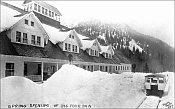
|
1. Big Four Inn Spring Opening, probably 1927. With a speeder on the railroad tracks. Can you tell us more about the Inn? Does it still exist? About the railroad and the speeder? In what direction are we looking? The photographer imprint is handwritten, Juleen, Number 747.
Fred Cruger notes: That's actually a full-sized Hartford-Eastern rail car arriving at the Inn, which was located right on the tracks near the base (north side) of Big 4 Mountain. Built by the Rucker Brothers immediately after they purchased the trackage from the Northern Pacific in the early 20s, the Inn burned to the ground in 1949. The Granite Falls Historical Museum has lots of interior and exterior pictures of the Inn. The Forest Service maintains a well-kept picnic area at the site of the Inn, where the main fireplace is the only remaining evidence of the building. We're looking West in this picture, toward civilization.
|
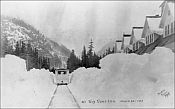
|
2. Big Four Inn Spring Opening, March 20, 1927. With a speeder on the railroad tracks. Can you tell us more about the Inn? Does it still exist? About the railroad and the speeder? In what direction are we looking? The photographer imprint is handwritten, Juleen, Number 745.
Fred Cruger notes: In this picture, we are looking East, toward the Cascades and up the track to Monte Cristo. John A. Juleen was a well-known Everett photographer and took many of the historic photos that have been preserved in the area.
|
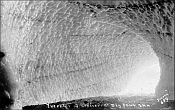
|
3. Interior of a glacier near Big Four Inn. Do you know where this might have been? The photographer imprint is handwritten, Juleen, Number 689.
Fred Cruger notes: This is a shot from inside the Ice Caves at the base of Big 4 Mountain. There is a well-kept trail leading from the site of the Big 4 Inn to the Ice Caves, but heavy flow washed out the main bridge that crosses the Stillaguamish just 1/2 mile from the Inn. The large laminated bridge girders were saved, and anchored near the bridge site, so repairs will hopefully happen in 2009. It's interesting to see women in long dresses hiking into the ice caves in some of our old photos.
|
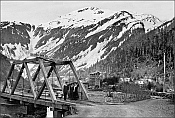
|
4. A bridge apparently newly constructed by the Eagle Bridge Co. near the town of Monte Cristo or was it the town of Mineral City. Do you know about the company? Was it built over a canyon or creek or river? What direction are we looking in? Can you identify the mountain in the background? Any guess as to the year?
Fred Cruger notes: This is definitely not Monte Cristo, but I guess there is some possibility that it's Mineral City (although I've not been able to confirm that). There is an interesting beer advertisement on the bridge, as I recall.
|
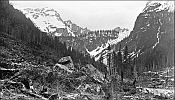
|
5. A scene near the town of Monte Cristo. Using the concentrator at the right, what direction are we looking in? Can you identify the mountain in the background and to the right? Any guess as to the year?
Fred Cruger notes: The distinctive rock at the center of this photo is one of the few remaining items in Monte Cristo that can be found easily. We have a picture that shows that rock in 1893, 1948, and 2003, all three shots taken from essentially the same spot looking southeast. This picture is unique in that it shows the rock while we're looking roughly northeast. The mountain on the right is Wilman's Peak, dominant in most early Monte Cristo photos. This picture was likely taken in the mid- to late-1890s.
|

|
6. This is a stunning view of the town — Mineral City or Monte Cristo? Thank you, Paul and Fred. Can you tell what direction are we looking in? Can you identify any of the buildings or details of the railroad?
Fred Cruger notes: This is Monte Cristo. The building dominating the picture is a lumber mill that ultimately became the Monte Cristo depot. The railroad water tank and turntable are at the left (the turntable is still there, and one of the few significant items besides the rock mentioned above that remain and can be easily identified by a casual visitor). In this view we are looking northwest down the tracks to Barlow Pass and civilization. When you hike in Monte Cristo today, you are hiking along the railbed that disappears into the rear center of the picture.
|
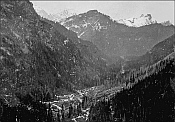
|
7. Can you identify the mountains around the valley in the center? What direction are we looking in?
Fred Cruger notes: This great view is looking down on Monte Cristo in a west-northwest direction (in my mind). If you look closely in a high-resolution version, you can see the depot and water tower, and the tracks to Barlow Pass follow the valley out of the picture. There is a long narrow wooden structure snaking its way out of the large concentrator at the lower left end of town - that structure is the cover over a horse-drawn tram that carried ore from where it was delivered by cable tram from mines on the mountain from which this picture was taken. There is a siding from the mainline that winds toward the concentrator from a switchback on the right side of the town in this picture.
|
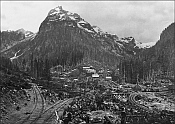
|
8. Another stunning view of the town — Mineral City or Monte Cristo? Can you identify the mountains in the background? What direction are we looking in?
Fred Cruger notes: Now we're looking straight at Wilman's Peak (southeast, in my mind) and the town of Monte Cristo. The mainline enters the picture at the lower right, and curves down to the depot, water tank, and turntable. There's a switchback that comes back up the hill to where we're standing, and a siding that then takes off in a winding route to the big concentrator. This is a classic view of Monte Cristo, and clea rly shows that unique rock I mentioned earlier, just off to the side of the switchback, near the center of the photo.
|

|
9. This is a fascinating photo of a milepost. Can you determine where it was? The year? The Denby truck? The Frank Waterhouse Company?
Fred Cruger notes: This was taken at a spot that now would be on the east end of the trestle Hwy 2 now crosses the flats from Everett toward higher ground at Cabellero (sp?) Hill. Denby made a lot of trucks. I may have an approximate date for this somewhere, and probably gave a good guess to Paul Dorpat.
|

 810 Central Ave.,
810 Central Ave., 








